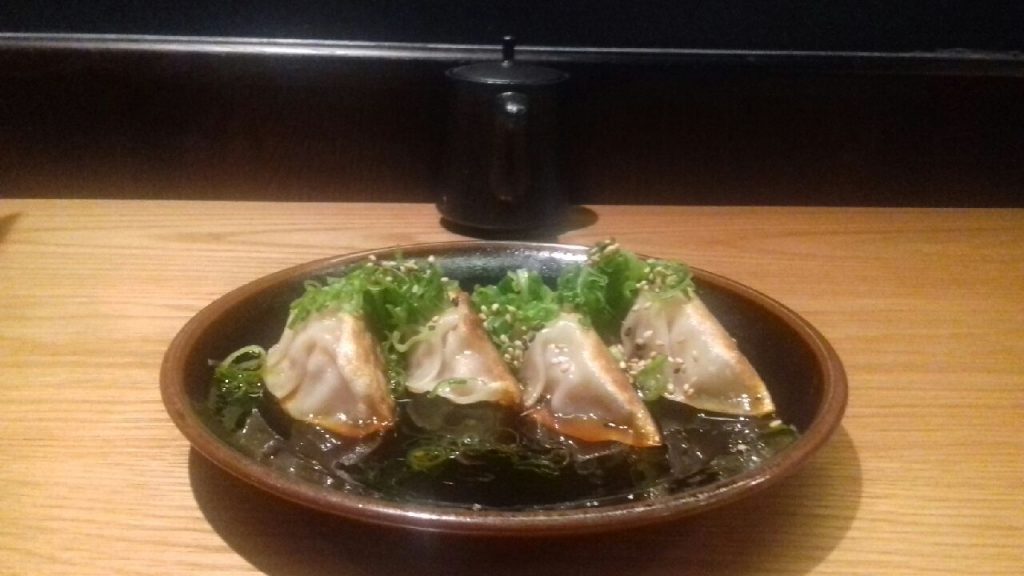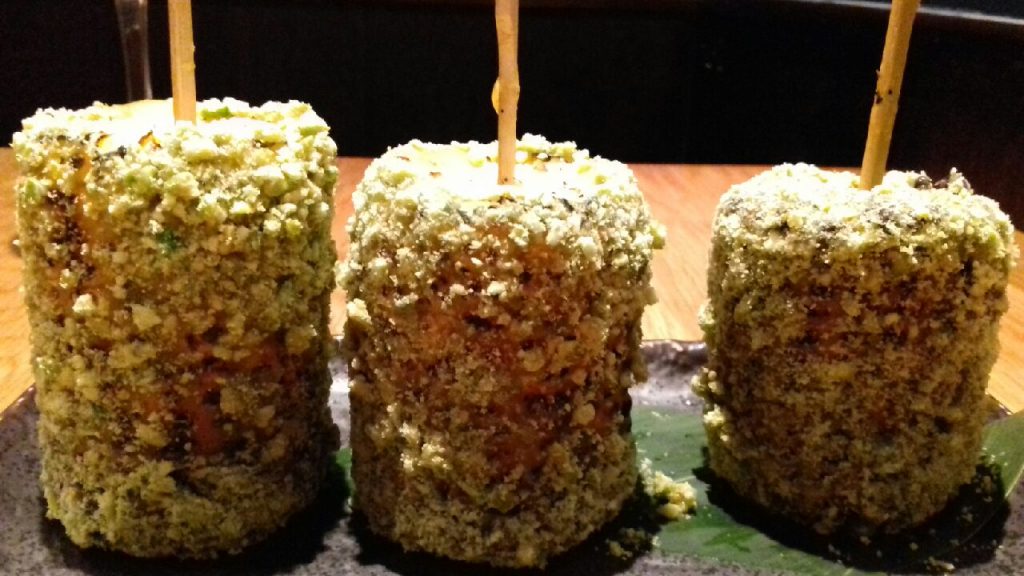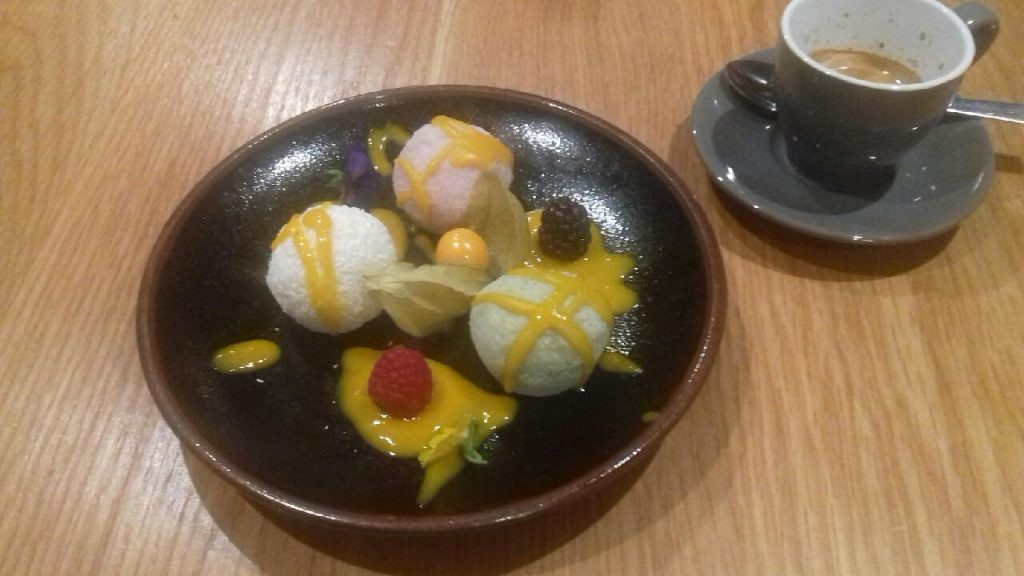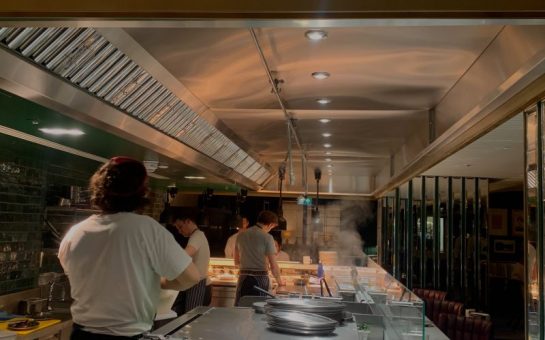By Francesca Montero
March 4 2020, 11.05
Follow@SW_Londoner
King Louis, the orangutan in Disney’s version of The Jungle Book, was onto something when he sang of his desire for man’s red fire.
He understood ‘the power of man’s red flower’, fire, such a potent element, it brings warmth and light: the fireside signalling a homecoming.
It’s not red fire, but a captivating white fire at the heart of the open kitchen of ROBATA, on Soho’s Old Compton Street, which specialises in Japan’s long-standing tradition of charcoal cooking known as robata, from which the restaurant takes its name.
Robata, meaning fireside, has a romantic origin: the cooking tradition was first introduced to Japan by ancient fishermen using boxes of hot coals to warm their food as they gathered their day’s catch.
This cooking method remains largely unchanged, using Japanese white charcoal, which burns almost completely cleanly, producing very little smoke or flame, and burning at a far higher temperature than western charcoal grills.
During the cooking process, the juices from the food drip onto the surface of the charcoal, forming smoke that rises and surrounds the food, and the high, intense heat and pure burn of the charcoal creates a crunchy outside that preserves the juicy, delicious inside, giving it a unique, pure flavour.
As I shook hands with Sofyan, the delightful chef manning the grill in the open kitchen on the night I visited ROBATA, I was mesmerised by the bright white glow of the huge piece of Japanese charcoal, burning as bright as lighted Magnesium in a school chemistry lab.
The intimate chef’s table at ROBATA undoubtedly takes its place among the best in the capital for diners wishing to witness the ancient art of Japanese charcoal grilling; the talent of precise, highly skilled cooking is a joy to behold.
The restaurant is a moody, hip space seating 50, and is decorated in inky blue.
ROBATA has an extensive drinks menu. If you wish to become better acquainted with sake, it’s the perfect place to find your favourite Japanese rice wine, a number of which are available served hot.
Our warm and friendly server Ben talked us through the menu, offering helpful suggestions and thanks to him, we ordered the perfect amount of food that showcased the versatility of the robata grill and the breadth of modern izakaya-style Japanese cooking.
We sipped on beautifully presented mocktails: Kurin, a well-shaken mix of pineapple juice, passion fruit and elderflower syrup and Ichigo, apple juice, strawberry puree, lemon juice and fresh strawberry were both refreshing, and delicious, complementing every dish that we chose.
We started with the small plates; dishes arrived, piping hot at the table, when ready.
The first to arrive was J.Fried Karaage, Japanese fried chicken which uses the thigh cut, served with gochujang mayo and fresh lime.
This was sensational: flavourful, succulent, juicy meat that gave off a glorious aroma as we bit into it: the delicate, beautifully seasoned batter casing was the perfect foil for the texture of the chicken.
It comes served with a Titian red gochujang mayo which is savoury, sweet and spicy, and delicious.
Full disclosure: I have never really understood people’s absolute devotion to fried chicken; it is often cited as the most popular choice for their last meal on earth.
But, now I understand perfectly. For my last meal on earth, I would always opt for anything cooked by my mother, but now, it should also come complete with a side of ROBATA’s J.Fried Karaage.
Stimulating all the senses, it prompted a full-on Homer Simpson drool.
Pork gyoza were four homemade mouth-watering dumplings filled with pork, water chestnut, and shitake, a wonderful combination of meat paired with the native Asian vegetables of the aquatic tuber and mushroom, sitting on a delicate spring onion and chilli soy sauce.

Tender shredded pork, parcelled in translucent wrappers of wheat flour and water made for a smooth dumpling texture, while tiny, soft single rings of spring onion and a warming chilli soy are the perfect bed on which to lay these beautiful little crescent pillows.
ROBATA offers a wide choice of skewers on the menu which showcase the talents of the grill.
Asparagus robata skewers were dressed with sweet sesame soy and sesame seed; melt in the mouth soft, highlighting that pure flavour that robata cooking is famed for.
Corn on the cob was glazed with miso and crusted wasabi pea, standing proudly on the plate, they looked like the work of Japanese artist Takashi Murakami, the refreshing, plump kernels of sweetcorn were enhanced by the crunchy heat of Japanese horseradish and sweet miso.

Such an innovative riff on corn on the cob: we’re not in the Harvester any more, Toto.
From the large plates we chose miso aubergine served with pickled shimeji mushrooms and ROBATA’s special red chilli.
The spongy, absorbent nightshade lent itself so well to being marinated in umami-rich miso paste and the white heat of the robata grill, the result was the sweetest, softest, yielding, lattice scored flesh.
The garnishing shimeji mushrooms, were all perfect long stems and petite globular caps.
A culinary triumph.
From the bowls, we chose kimchi rice as an accompaniment, which arrived with a huge soft yolk fried egg, sitting atop the rice like a quivering blanket, the homemade kimchi, nori, and spring onion gave it a pickled kick.
The dessert menu was small yet perfectly formed: rather like the coconut, raspberry and green tea ice cream mochi, which arrived decorated with a vivid passion fruit sauce, garnished with physalis, raspberry, and blueberry.
Ice cream mochi – soft, pounded sticky rice dumplings formed around an ice cream filling, the confection is flavoured by the ice cream, whilst the mochi provides the sweetness.
As I came to expect, they were expertly done and were the perfect way to round off our meal.

Espresso is good here, ROBATA use Illy coffee, in my book a reassuring kite mark of quality in a kitchen.
The cleverness of the menu is that you can visit several times and never have two meals the same; each time picking from different sections be it: raws & sushi, small & large plates, robata skewers, bao buns or bowls.
ROBATA will become a fixture on my West End routine – things I make time for when in Soho: a Bar Italia cappuccino, a browse in Foyles, a film at the Curzon, deli staples from Camisa and Sons, and now ROBATA for some J.Fried Karaage.



